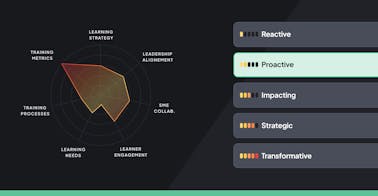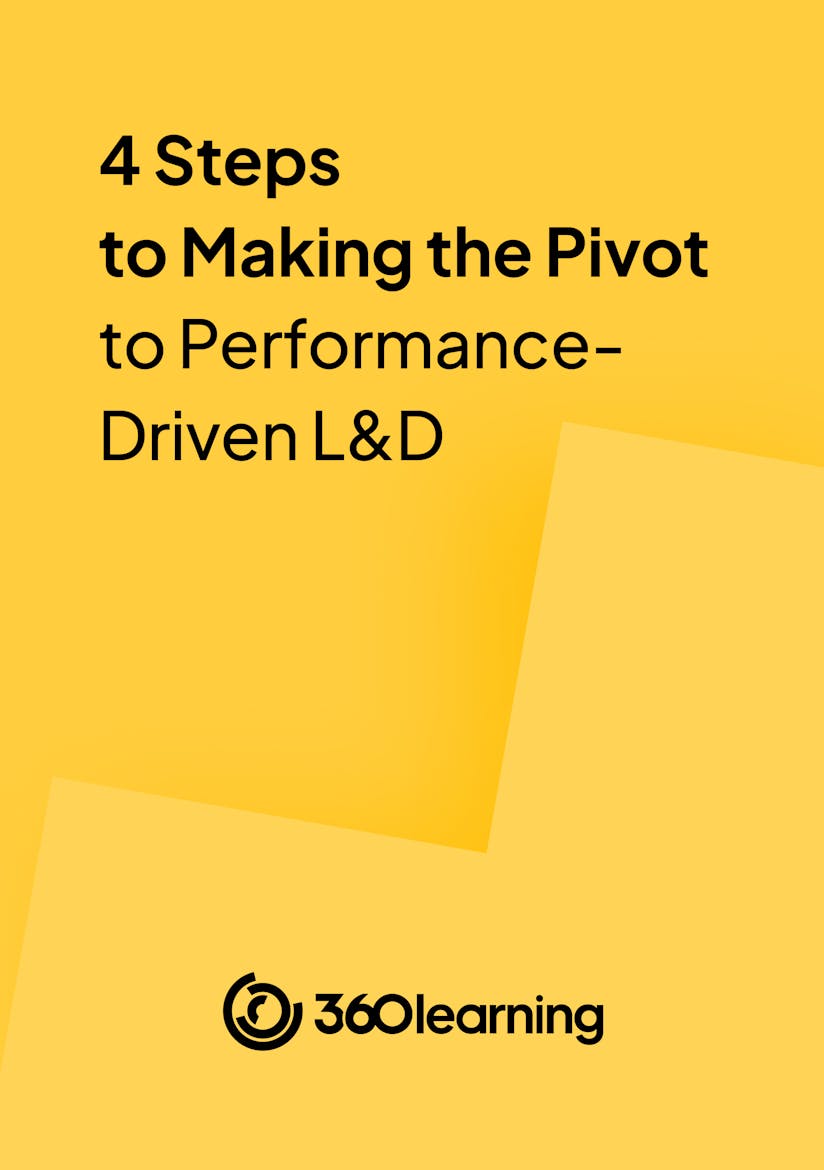
Does this sound familiar? You're an L&D leader, a manager, or perhaps even an executive, constantly striving for growth, yet something feels off. Despite your best efforts, are critical skill gaps still emerging? Is employee engagement flagging? Are you still battling the perception that L&D is "just a cost"? If so, you're not alone, but your company might be missing out on significant potential.
As an L&D professional since 2013, I've spent over a decade watching a common, yet often overlooked, misconception play out: the belief that L&D is a mere administrative function, a necessary expense, instead of the powerful engine that truly drives sustained organizational success. It's time to explore some honest truths and understand why this traditional view might be quietly limiting your company's future.

Impactful, demonstrable L&D in 4 simple steps
By providing your contact info, you agree to receive communications from 360Learning. You can opt-out at any time. For details, refer to our Privacy Policy.
The illusion of "just training": what modern L&D actually is
The outdated idea that L&D is simply about delivering courses is holding progress back. A truly robust L&D foundation isn't a passive checkbox; it's a dynamic, integrated ecosystem built on core competencies that propel tangible business results, directly influencing your bottom line. I know this because I build these systems every day.
E-learning development is about purposeful design, not just pages
I don't just create static presentations or digitized manuals. I focus on crafting immersive, engaging digital experiences. This includes microlearning modules, interactive simulations, and personalized learning paths that genuinely stick and drive skill acquisition. Purposeful e-learning isn't about content volume; it's about reducing time-to-competency for your team.
Performance-driven learning connects directly to profit
It's not just about content consumption. I meticulously link learning initiatives directly to performance goals. This ensures training translates into measurable, impactful improvements for individuals, teams, and the entire organization. For example, targeted leadership training can directly boost team metrics like project completion rates or reduce operational errors.
Strategic learning analytics unlock actionable data
I ditch the guesswork. I leverage data—not intuition—to pinpoint what's truly effective, identify critical skill gaps before they widen, and prove the undeniable ROI of L&D investments. I track key L&D metrics like course completion rates, performance improvements post-training, retention of skilled employees, and skill acquisition velocity within teams. This data empowers strategic decisions.
Agile content creation taps into your internal goldmine
I develop highly relevant, up-to-date learning materials tailored precisely to employee and organizational needs. A crucial part of this is unlocking internal expertise and empowering your subject matter experts (SMEs) to contribute. This approach significantly speeds up content creation and ensures a level of practical relevance that generic, off-the-shelf solutions simply can't match.
Dynamic collaborative learning unleashes collective power
Often overlooked, this pillar empowers employees to learn actively from each other. Fostering peer-to-peer knowledge sharing cultivates a powerful sense of community, enhances collective intelligence, and accelerates problem-solving. Platforms like 360Learning excel at facilitating this kind of collaborative, user-generated, and internal expert-led training content. They transform passive learners into active contributors.
The alarming reality: why weak L&D Is quietly limiting your growth
My decade of experience, coupled with compelling industry data, reveals an important truth: companies with underdeveloped L&D infrastructures face significant disadvantages. Neglecting this area isn't just inefficient; it's a costly mistake that can quietly undermine your progress.
The talent drain is plummeting engagement
Employees crave growth and clear development opportunities. If your organization isn't providing valuable learning paths, your top talent will seek them elsewhere. Consider the significant cost of constant recruitment, lengthy onboarding processes, and the invaluable institutional knowledge that walks out the door with departing employees. You might be losing your best and brightest. Gallup's research, for instance, consistently highlights the strong correlation between employee development opportunities and retention rates—showing that employees are more likely to stay when they feel invested in.
Skills gaps cripple output and stifle innovation
Outdated skills directly translate into inefficiencies, errors, and stagnation. Learning isn't a distraction from work; it's the critical pathway to enhanced output and breakthrough ideas. Without continuous upskilling, your workforce simply cannot keep pace with rapid market changes. This leads to missed opportunities, reduced competitiveness, and ultimately, falling behind. Deloitte's human capital trends reports often underscore how organizations embracing continuous learning achieve higher levels of innovation and productivity.
Without an agile, responsive L&D function, your workforce remains rigid and unable to respond effectively to new challenges or opportunities. This makes your company profoundly vulnerable in competitive and uncertain environments.
The competitive edge erosion
Strong learning cultures consistently outperform their peers. Research from organizations like the Association for Talent Development (ATD) consistently affirms direct correlations between L&D investment and higher employee retention, superior engagement, and remarkable adaptability. Ignoring this trend doesn't just mean standing still; it means actively sacrificing your competitive advantage to those who embrace continuous learning.
Forge ahead: building your company's indestructible L&D backbone
It's abundantly clear: a robust L&D function isn't a perk; it's a strategic imperative. So, how can your organization cultivate this essential backbone for sustained success? Based on my experience, these actionable strategies make all the difference.
- Empower learner autonomy: I advocate for shifting the paradigm from mandatory, top-down training to enabling self-directed learning. Inspire your people to take ownership of their development and explore skills vital for their growth, and the company's future. This builds intrinsic motivation and genuine engagement, turning learners into drivers of their own success.
- Integrate learning seamlessly: I don't believe in siloed learning that feels like an interruption. I recommend weaving learning opportunities directly into daily workflows, projects, and career progression frameworks. Make development a natural, ongoing part of the work experience, ensuring it's always relevant and accessible at the moment of need.
- Champion internal collaboration: Your employees are an untapped reservoir of knowledge. I encourage fostering robust peer-to-peer sharing through mentorship programs, dynamic communities of practice, and actively encouraging user-generated content—something platforms like 360Learning truly excel at. Empower your internal experts to train others.
- Embrace data-driven decisions: Stop making assumptions. I urge you to utilize powerful learning analytics to precisely identify skill gaps, rigorously measure program effectiveness, and definitively prove the tangible ROI of your L&D initiatives to leadership. This is how you speak their language and secure vital future investment.
- Cultivate a culture of celebration: Acknowledge and enthusiastically reward learning achievements. When employees see their efforts valued and celebrated, they become profoundly more motivated to continue their development journey, creating a virtuous cycle of continuous improvement that permeates the entire organization.
Your imperative role: from skeptic to L&D champion
Every individual within your organization holds a vital role in this transformative journey. This isn't just an L&D department's job; it's a company-wide commitment that requires unified effort.
L&D professionals
I believe we must transcend the role of mere course administrators. We must become strategic business partners, directly linking learning to key organizational objectives, and demonstrating undeniable impact with data. This includes empowering SMEs to create training courses—passing on proprietary skills and institutional knowledge, democratizing learning creation.
Managers
Step up as coaches and mentors. Actively encourage your teams to engage in learning, allocate dedicated time for development, and authentically model a growth mindset. Your influence as a direct leader is critical to the adoption and success of any learning initiative.
Executive leaders
Recognize L&D as a critical business lever, not just a department. Allocate the necessary resources, champion a pervasive learning culture from the top down, and demand rigorous, data-driven insights on its impact. Your buy-in and visible support are paramount for cultural shift.
In over ten years dedicated to this field, I've witnessed the profound and transformative power that L&D wields when companies truly embrace it. It shifts you from merely reacting to market changes to proactively shaping your own destiny. A strong L&D backbone isn't just about upskilling; it's about forging an agile, resilient, and relentlessly innovative enterprise that thrives in any environment.
So, the evidence is clear. The future belongs to organizations that prioritize continuous learning. Is your organization ready to stop simply "training" and start truly thriving?




